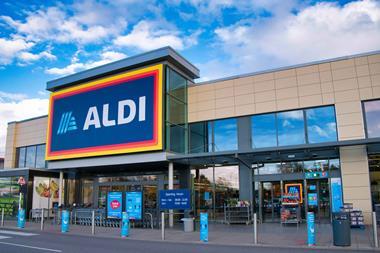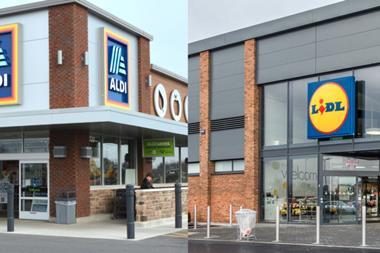A year on from the seismic shift felt in the grocery market when discounter Aldi overtook supermarket giant Morrisons to fourth place, how are the two businesses tracking?

In the 12 weeks to September 13, 2022, Aldi grew sales by 18.7%, taking its grocery market share to 9.3%. In the process, it overtook Morrisons to become the fourth-largest grocer in the country.
While long predicted by Kantar data and City analysts, the moment still represented a profound shift, shattering the dominance of the big supermarket chains, which had a vice-like grip on UK food retailing for decades.
The moment was also decisive in that it marked the point at which a cost-of-living problem deepened into a cost-of-living crisis – one which has persisted throughout 2023 and threatens to go beyond.
In the time since, Aldi has gone from strength to strength, sustaining circa 20% sales growth month on month, while widening the market share gap on Morrisons in the process.
So how far has the gap between Aldi and Morrisons grown in the last 12 months? And is there any way back for the supermarket chain in the current economic environment?
Widening gap
The data shows just how far back Morrisons has fallen in the intervening 12 months. In the four weeks to September 3, 2023, the gap between Morrisons and Aldi stood at 1.5 percentage points.
Aldi’s growth over the past year has been supercharged by the cost-of-living crisis. Shoppers have switched in their millions as stubbornly high inflation, which peaked at the historic level of 19.2% in March, have persisted for months and months.
However, some relief at least is in sight. While food prices remain at above-average levels – 12.2% inflation, according to the latest Kantar figures for September – they are beginning to show some signs of tailing off, which may in turn see consumers return to previous shopping behaviours.
On the day that Aldi opened its 1,000th store, it also confirmed plans to open a further 500 new stores in the UK before 2025.
However, some analysts predict that the discounter will struggle to meet this ambition as it deals with competition from Lidl and the risks of cannibalising sales from itself.
“[Aldi] has been benefiting from unnatural momentum with UK living standards squeezed – they are now rising – and one in 10 UK supermarket pounds suggests that there are fewer areas of virgin territory for the brand,” says Shore Capital’s Clive Black. “Therefore, we assert that the trade has gone through peak Aldi.”
However, global insights leader at IGD Bryan Roberts disagrees. He believes there’s still “lots of headroom for Aldi to grow”.
Roberts says Aldi is very willing to experiment with store formats and locations due to it being “very keen to win out in urban locations”. This flexibility is a key part of why there are “a lot more people out there who would like to shop with Aldi who can’t”.
“It’d be churlish to rule out their ongoing expansion,” he added. “Their appeal will be enduring beyond this inflationary period because a lot of the reasons they’re successful go beyond price”.
Back up the ladder
This year has seen Morrisons’ market share continue to erode. On January 22, Morrisons had 9.1% of the market, which has since fallen to 8.6% in the most recent Kantar data.
While the market share gap between Aldi and Morrisons has grown over the last 12 months, Roberts says closing the distance will not be top of Morrisons’ agenda now.
Morrisons was slower than its competitors when it came to investing in price to offset growing food prices, which Shore Capital’s Black puts down to “balance sheet constraints”.
However, in the back half of 2022 and particularly since the start of the year, Morrisons has made investing in price a priority.
The supermarket giant slashed prices on more than 1,000 items in January and followed that up with a further £25m investment in February – bringing its total investment to more than £148m in a six-month period.
At a time when price has been the dominant driving factor in grocery customers’ shopping behaviour, this has helped to at least stem the tide.
“They’ve been the first to admit they’ve had a tough couple of years,” says Roberts. “Recently, they’ve been a lot sharper around their loyalty offering, a lot sharper on pricing and promotions, and a lot better in terms of working collaboratively with suppliers.
“At a time when other supermarkets are moving away from counters and that more service-led aspect of retailing, Morrisons has that point of difference. It maybe hasn’t maximised its unique selling points in service, in fresh food, where they’ve still got a nice story to tell.”
There is light at the end of the tunnel for Morrisons and food prices are coming down, but the outlook for the run into Christmas remains tough.
“Consumers are still worried about the impact of rising grocery prices,” says Fraser McKevitt, head of retail and consumer insight at Kantar.
“After a full year of double-digit grocery inflation, it’s no surprise that just under a quarter of the population consider themselves to be struggling financially.”
For now, Morrisons doesn’t look like it will be overtaking Aldi any time soon. However, with the macroeconomic picture still looking particularly turbulent headed into the crucial golden quarter, climbing back up the ladder is not likely to be its main priority.


























No comments yet